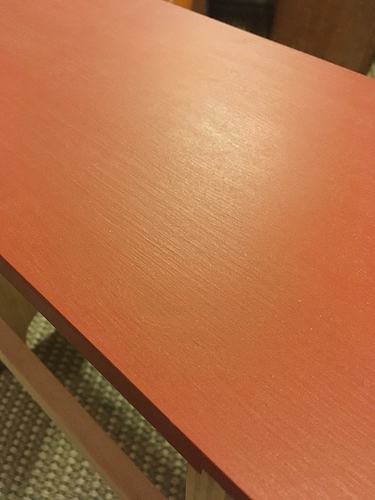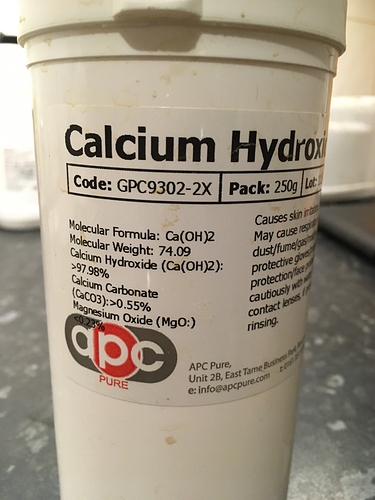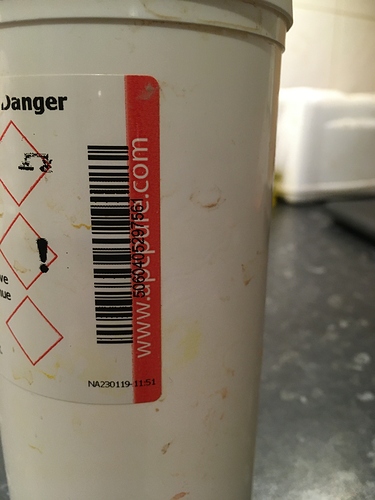Looks great, crisp simplicity. The milk paint makes for a great (but complimentary) contrast
Shaker peg rail/ milk paint
I am gradually realising some nice things. I need a bench now, then I can make some furniture
Yes not sure what is added but it will keep in the tin indefinitely, unless you thin it with water in which case it will foul in a couple of days (and then you’ll really know about it!  )
)
What’s you’re recipe for the milk paint Giles. Online I found different versions but not sure how good they are.
8 pints skimmed milk
472ml white vinegar or white wine vinegar
112g hydrated lime
200gm pigment or enough to make it opaque which can be less than 200
You can reduce the recipe
Skimmed milk at room temp pour the vinegar and milk into a flattish container simultaneously. This means you don’t have to stir which will break up the curds. Pour together and leave overnight. Strain through cheese cloth. Rinse with cold water three times until vinegar smell is gone.
Leave to drain for a bit, squeeze out a bit too if you like.
Put in container, add lime and stir, the curds will dissolve.
Add pigment and water you want a double cream consistency ish , it needs to be paintable don’t thin it too much.
Use fairly promptly. Keep in the fridge
It forms a crust in the fridge just stir it in.
You can strain the paint after combining all the ingredients. The pigment is heavy so it needs stirring. You can add additional coats after an hour. Once cured it’s hard as a rock. It may get thicker over time you can add a touch more water. Best to just get it painted . The first coat tends to look awful. If it’s used over wood only sand to 120 max. No sanding is necessary between coats unless you are removing blemishes etc,
Great! Thank you! I will give that a try!
Enjoying the milk paint, do you know if it can be used for exterior work?
For another project we’re just starting to experiment with iron acetate wood stain, and are looking for anything that might be used for exterior work, ideally using natural pigments and materials…if you have any experience/knowledge of this stuff?
I have no experience of using it outside but I am fairly sure it was used to paint the outside of houses in the states. It doesn’t wash away once it cures. They added chalk to it back in the day, very considerable quantities. There are original recipes online from 1800 or so. If you do add chalk you will need a stirrer, it drops to the bottom in minutes and seems like a solid mass until you get it moving. I am sure it has thixotropic qualities. You will have to do some research or just make some and paint a shed door or something similar. If you do a test panel I would imagine you need to keep one side dry if that’s the intended use.
This is a bench top I painted with milk paint you can still see the wood grain through the paint. It’s not really showing in the picture although you can see half a knot in the foreground.You wouldn’t want a crackle finish for exterior use but this has a crackle finish which, is what you get if you wait for the paint to get old for the last coat .
Hey @Giles ,
I’m looking to use milk paint for the tool chest I’m starting. Will go with 2 coats red, 2 coats black then oil and wax.
Given lockdown I’m looking for pigments online but am lost. Do you have any suggested options? Any idea where you might get the lime in a small quantity? Googling hydrated lime just have massive 25kg bags of the stuff!
Trying to work out if I can do it significantly cheaper than just buying powdered milk paint
Thanks in advance,
Matt
Maybe I’m in business… How about 100g each of red and black from here.
Plus 1kg of hydrated https://www.ebay.co.uk/itm/APC-PURE-Calcium-Hydroxide-98-7-1Kg-Hydrated-Lime-A-/162674812770?_trksid=p2349624.m46890.l49292
I think pigment (and postage) + lime + milk + vinegar would put me at c.£23 Vs £38ish for the powdered stuff.
Sorry
I didn’t see your email. Are you sorted? Great art in shoreditch sell a big range of pigments.
You will need to follow the recipe and method I outlined exactly. Get in touch if you need to.
I expect you have done it by now. Do let me know.
Hey @Giles I haven’t done it yet… Taking my time working through the tool chest to enjoy the process!
Do you reckon the pigments I linked in my previous comment would work? Can’t imagine the place in Shoreditch is open currently and even if they were, not a great time to go shopping
Well I am fairly sure great art are online suppliers too. They’re a big outfit I think.
I will check out the pigments you mentioned, basically earth pigments work or anything with some weight to it. Reds and blacks tend to be good. Clues are often in the name.
The pigment you mentioned all look good. Make sure you get enough, if you use pure pigments for each colour you can just get more if you don’t have enough. You want to get all your coats on about 4 hours apart. The paint deteriorates even over 24 hours in the fridge. So when you make it, use it. As you are doing two coats of each it shouldn’t be a problem. The first coat can look terrible, don’t panic and don’t over thin it. It dries so quickly you will have time to do a test piece. You want to use skimmed milk at room temp, pour the milk and vinegar simultaneously, don’t stir even once. If you break up the curds they will flush through the cheese cloth when you rinse. It’s all about the curds, once you have your clean curds the rest is straight forward. Keep me posted, I am in two minds about a chest myself.
My pigments arrived today - just need to grab some hydrated lime and then I can crack on!
Cool, make sure you add room temp skimmed milk simultaneously and do not stir or agitate at all. This keeps the curds intact and makes washing with fresh water possible. If you break up the curds they will flush through the cheese cloth when you wash them. Once you have the curds it’s a doddle as long as you get everything done fast. It dries so fast you can easily do three coats in a day. You could easily do more. I would never make milk paint and use it days later, it changes consistency and develops a foam. Still usable but sub optimal. Crackle can develop with old paint, you can harness that characteristic. One final point, the first coat tends to look horrendous. Just stick with it and use proper technique, masking tape works well. Any news on the naked woodwork bench dvd, I sent you my email?
I dropped you an email I thought? I’ll double check.



